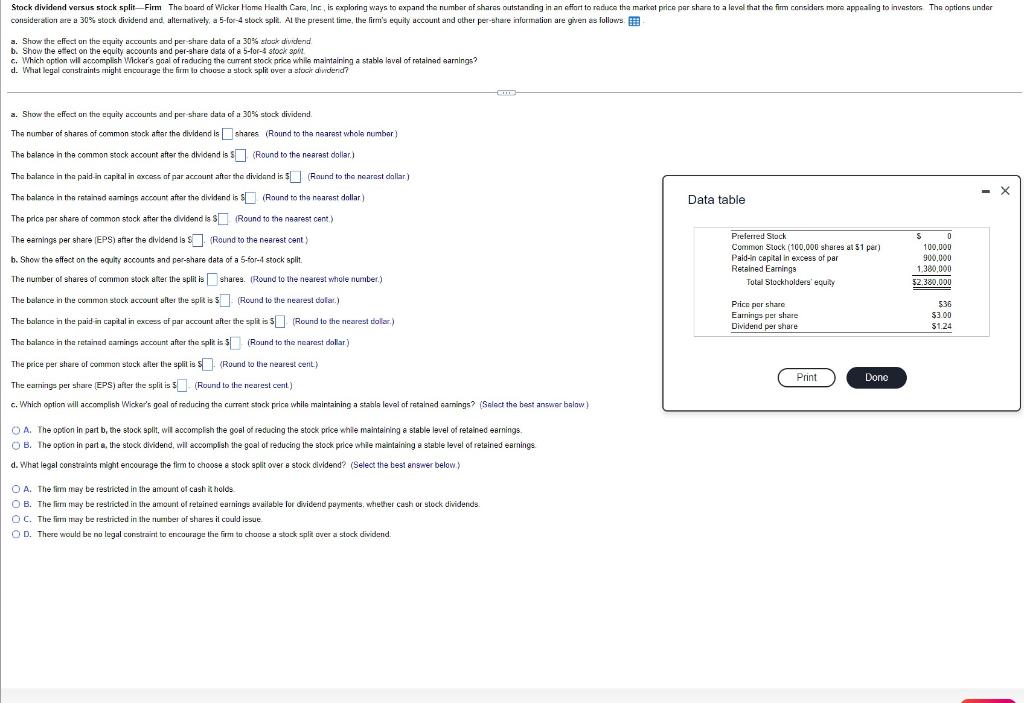
Stock dividend versus stock split-Firm The board of Wicker Home Health Care, Inc. is exploring ways to expand the number of shares outstanding in an effort to reduce the market price par Share to a level that the firm considers more appeaing to investors. The options under consideration are a 30% stock dividend and, alternatively, a 5-for-4 stock split. Al the present time, the firm's equity account and other per-share information are given as follows B a. Show the effect on the equity accounts and per share data of a 30% stock dividend b. Show the effect on the equity accounts and per-share data of 5-for-4 stock 30 C. Which option wil accomplish Wicker's goal of raducing the current stock price while maintaining a stable lavel of retained earnings? d. What legal constraints might encourage the firm to choose a stock split over a stock dividend - X Data table a. Show the effect on the equity accounts and per share data of a 30% stock dividend The number of shares of common stock after the dividend is shares (Round to the nearest whole number) The balance in the common stock account after the dividend is S (Round to the nearest dollar.) Tha balance in the paid in capital in excess of par account after the dividend is $(Round to the nearest dallar) Tha balance in the retained earings account after the dividend is (Round to the nearest dollar) The price par share of common stock after the dividend is S Round to the nearest cent) The earings per share (EPS) after the dividend is $. Round to the nearest cent) b. Show the effect on the equity accounts and per-share data of a 5-for-4 stock spilt. a The number of shares of common stock after the split is shares. Round to the nearest whole number.) The balance in the common stock account after the solitis (Round to the nearest dolar) The balance in the paid a capital in excess of par account after the pltiss (Round to the nearest dolar) Tha balance in the retained samnings account after the spleis (Round to the nearest dollar) The price per share of common stock after the split is $ Round to the nearest cent.) The eamings per share (EPS) after the split is $ (Round to the nearest cent) c. Which option will accomplish Wicker's goal of reducing the current stock prica while maintaining a stable level of retained samings? (Select the best answer balow) Preferred Stock Common Stock (100,000 shares at 51 per Pald-in capital in excess of par Retained Earnings Total Stockholders' equity $ 0 100,000 900,000 1.380.000 52.380,000 Price per share Earings per share Dividend per shure 536 $3.00 $1.24 0 Print Done O A. The option in part b, the stock split wil accomplish the goal of reducing the stock price while maintaining a stable level of retained earnings B. The opion in part a, the stock dividend, wil accomplish the goal of reducing the stock price while maintaining a stable level of retained earnings d. What legal constraints might encourage the fimm to choose a stock split over 8 stock dividend? (Select the best answer below) ( O A. The firm may be restricted in the amount of cash holds OB. The firm may be restricted in the amount of retained earnings available for dividend payments, whether cash or stock dividends OC. The firm may be restricted in the number of shares il could issue OD. There would be no legal constraint to encourage the firm to choose a stock split over a slock dividend







